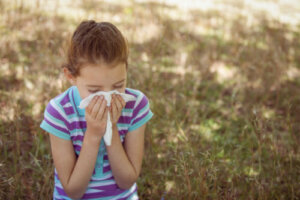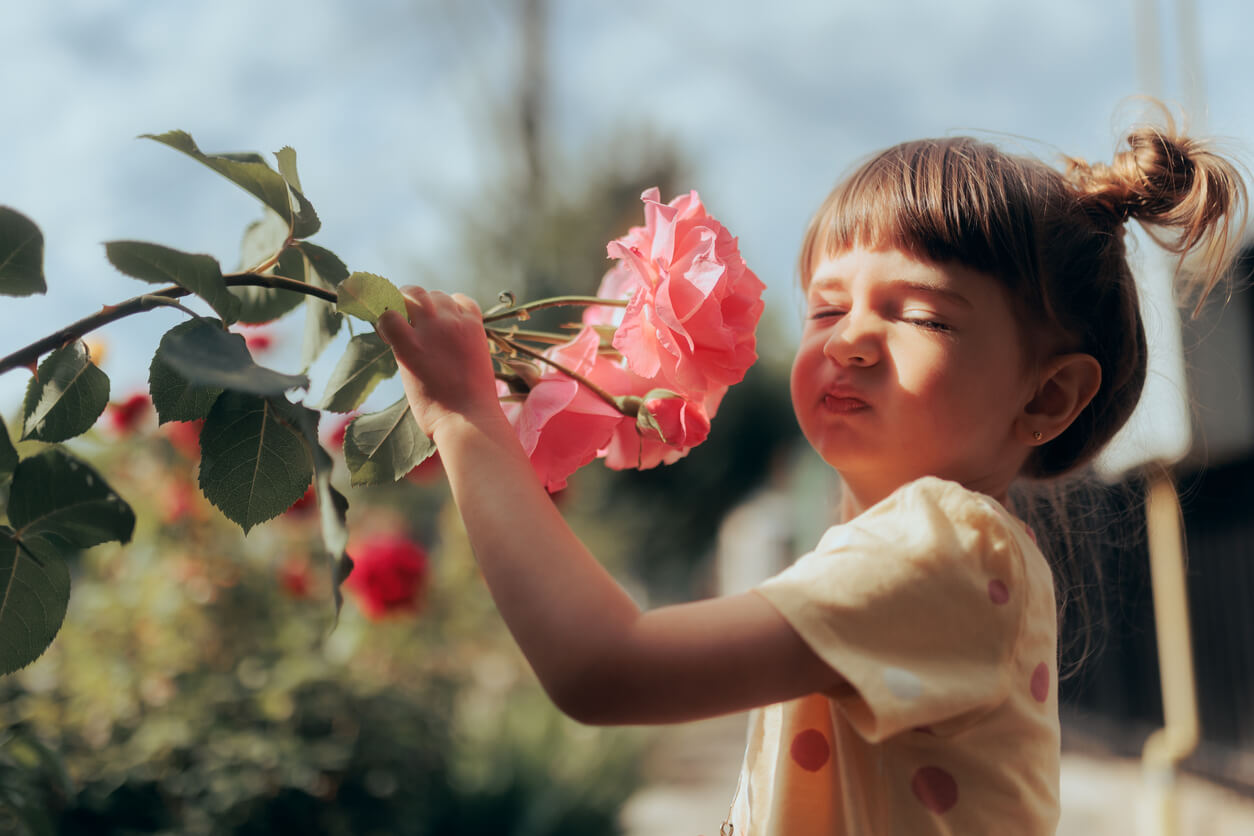10 Most Frequent Summer Allergies in Children


Written and verified by the dermatologist Maria del Carmen Hernandez
During summer vacation, various allergies tend to flourish in children, which are characteristic and typical of the summer. Therefore, attention should be paid to this time of the year to prevent complications. Keep reading to discover the 10 most frequent allergies in children during the summer.
The most frequent allergies in children in summer
Whatever the cause of the allergy, it’ll accompany the child everywhere. However, it’s important to be aware of various allergens and triggers that tend to be most prevalent during the summer. Here are the most common ones.
1. Allergies to insect bites or stings
Insect bites tend to increase in incidence during the summer months. Also, there’s a greater surface of the body exposed to various bugs found outdoors.
The most frequent are those caused by wasps and bees and can trigger serious clinical pictures in children.
2. Sun allergy
Although the term “sun allergy” isn’t technically correct, it’s a superficial reaction of the blood vessels to ultraviolet rays or sunlight. In fact, the characteristic clinical manifestations are eczema, papules, and pruritus after prolonged sun exposure.
Skin reactions can also be observed if, prior to sun exposure, there was direct contact with certain drugs, creams, perfumes, or cosmetics.
3. Allergy to chlorine in swimming pools
Chlorine in swimming pools has irritant properties and the ability to trigger significant allergic reactions in the skin. However, articles published by the Spanish Society of Clinical Immunology, Allergology, and Pediatric Asthma also demonstrate adverse effects on the eyes and respiratory tract.
Prolonged exposure to swimming pools isn’t recommended for children with atopic dermatitis.

4. Pollen allergy
Not only do plants pollinate in the spring, but they can also pollinate during the summer months. Grasses and Parietaria do so especially in summer, mainly in woodland areas of fields.
This type of allergy is often difficult to manage, so parents are advised to have antihistamines, inhalers, or medical treatment ready for use, according to their pediatrician’s recommendations.
5. Allergy to sunscreens
Some cosmetic products can cause skin reactions such as burning, irritation, and hives due to their ingredients.
Chemical sunscreens are absorbed into the skin and can cause allergic reactions. In contrast, physical or mineral sunscreens are better tolerated by reactive skin, as their components aren’t absorbed.
6. Latex allergy
Latex allergy is one of the skin reactions with increasing incidence over time. This is due to the fact that there are many objects used in daily life that are made of this component. In addition, during the summer, accessories such as floaties, pool inflatables, swim caps, or goggles tend to be used more frequently.
Some of the symptoms caused by latex are the following:
- Rhinoconjunctivitis
- Urticaria
- Asthma
- Respiratory symptoms
- Anaphylaxis
7. Allergy to dust mites
Mites are arachnid arthropods that live in house dust, which is why they’re cataloged as one of the main causes of environmental allergy. Summer conditions, where temperature and humidity are high, contribute to this type of allergy.
In addition, rental homes or cottages often accumulate dust because they’ve remained unkempt and closed throughout the year. For this reason, it’s important to carry out proper hygiene and ventilation in the place in advance.

8. Food allergies
According to a publication by the Spanish Association of Pediatrics, the most prevalent allergies include the following:
- Pollen
- Dust
- Certain foods
Summer is characterized by the highest number of food allergies caused by the increased consumption of allergenic foods. It’s also a time of the year when it’s more common to eat away from home.
For example, melons, watermelons, plums, or apricots can trigger major reactions and even anaphylaxis. Also, shellfish consumption can be one of the causes, but its incidence isn’t as high in children.
9. Allergies to pet hair
Although allergies to animal hair are a condition that occurs throughout the year, in summer, there’s a greater likelihood of suffering reactions, as there’s usually more contact with pets.
As in other types of allergies, it’s best to avoid what causes the reaction in the child. It’s also important to wash the child’s hands after touching animals.
10. Grass allergy
Grass grows quickly and in any location, which makes it impossible to avoid when enjoying the outdoors. Symptoms can range from ocular and/or nasal symptoms to urticaria or asthma, according to studies by the American Academy of Allergy Asthma & Immunology.
Prevention is the best medicine
Children are vulnerable to spontaneous and accidental allergic reactions, so parents of atopic children are advised to take extreme care to prevent them.
It’s always advisable to carry the first aid kit indicated by the allergist to be used in case of need.
During summer vacation, various allergies tend to flourish in children, which are characteristic and typical of the summer. Therefore, attention should be paid to this time of the year to prevent complications. Keep reading to discover the 10 most frequent allergies in children during the summer.
The most frequent allergies in children in summer
Whatever the cause of the allergy, it’ll accompany the child everywhere. However, it’s important to be aware of various allergens and triggers that tend to be most prevalent during the summer. Here are the most common ones.
1. Allergies to insect bites or stings
Insect bites tend to increase in incidence during the summer months. Also, there’s a greater surface of the body exposed to various bugs found outdoors.
The most frequent are those caused by wasps and bees and can trigger serious clinical pictures in children.
2. Sun allergy
Although the term “sun allergy” isn’t technically correct, it’s a superficial reaction of the blood vessels to ultraviolet rays or sunlight. In fact, the characteristic clinical manifestations are eczema, papules, and pruritus after prolonged sun exposure.
Skin reactions can also be observed if, prior to sun exposure, there was direct contact with certain drugs, creams, perfumes, or cosmetics.
3. Allergy to chlorine in swimming pools
Chlorine in swimming pools has irritant properties and the ability to trigger significant allergic reactions in the skin. However, articles published by the Spanish Society of Clinical Immunology, Allergology, and Pediatric Asthma also demonstrate adverse effects on the eyes and respiratory tract.
Prolonged exposure to swimming pools isn’t recommended for children with atopic dermatitis.

4. Pollen allergy
Not only do plants pollinate in the spring, but they can also pollinate during the summer months. Grasses and Parietaria do so especially in summer, mainly in woodland areas of fields.
This type of allergy is often difficult to manage, so parents are advised to have antihistamines, inhalers, or medical treatment ready for use, according to their pediatrician’s recommendations.
5. Allergy to sunscreens
Some cosmetic products can cause skin reactions such as burning, irritation, and hives due to their ingredients.
Chemical sunscreens are absorbed into the skin and can cause allergic reactions. In contrast, physical or mineral sunscreens are better tolerated by reactive skin, as their components aren’t absorbed.
6. Latex allergy
Latex allergy is one of the skin reactions with increasing incidence over time. This is due to the fact that there are many objects used in daily life that are made of this component. In addition, during the summer, accessories such as floaties, pool inflatables, swim caps, or goggles tend to be used more frequently.
Some of the symptoms caused by latex are the following:
- Rhinoconjunctivitis
- Urticaria
- Asthma
- Respiratory symptoms
- Anaphylaxis
7. Allergy to dust mites
Mites are arachnid arthropods that live in house dust, which is why they’re cataloged as one of the main causes of environmental allergy. Summer conditions, where temperature and humidity are high, contribute to this type of allergy.
In addition, rental homes or cottages often accumulate dust because they’ve remained unkempt and closed throughout the year. For this reason, it’s important to carry out proper hygiene and ventilation in the place in advance.

8. Food allergies
According to a publication by the Spanish Association of Pediatrics, the most prevalent allergies include the following:
- Pollen
- Dust
- Certain foods
Summer is characterized by the highest number of food allergies caused by the increased consumption of allergenic foods. It’s also a time of the year when it’s more common to eat away from home.
For example, melons, watermelons, plums, or apricots can trigger major reactions and even anaphylaxis. Also, shellfish consumption can be one of the causes, but its incidence isn’t as high in children.
9. Allergies to pet hair
Although allergies to animal hair are a condition that occurs throughout the year, in summer, there’s a greater likelihood of suffering reactions, as there’s usually more contact with pets.
As in other types of allergies, it’s best to avoid what causes the reaction in the child. It’s also important to wash the child’s hands after touching animals.
10. Grass allergy
Grass grows quickly and in any location, which makes it impossible to avoid when enjoying the outdoors. Symptoms can range from ocular and/or nasal symptoms to urticaria or asthma, according to studies by the American Academy of Allergy Asthma & Immunology.
Prevention is the best medicine
Children are vulnerable to spontaneous and accidental allergic reactions, so parents of atopic children are advised to take extreme care to prevent them.
It’s always advisable to carry the first aid kit indicated by the allergist to be used in case of need.
All cited sources were thoroughly reviewed by our team to ensure their quality, reliability, currency, and validity. The bibliography of this article was considered reliable and of academic or scientific accuracy.
- En torno al 20% de los niños españoles tiene algún tipo de alergia. [Internet] Disponible en: https://www.aeped.es/noticias/en-torno-al-20-los-ninos-espanoles-tiene-algun-tipo-alergia
- Mowing down your grass allergies. [Internet] Disponible en: https://www.aaaai.org/Tools-for-the-Public/Biblioteca-de-condiciones/Biblioteca-de-alergia/Arrasando-con-sus-alergias-al-cesped
- ¿El cloro de las piscinas causa alergia?. [Internet] Disponible en: https://pacientes.seicap.es/es/-el-cloro-de-las-piscinas-causa-alergia-_89671
This text is provided for informational purposes only and does not replace consultation with a professional. If in doubt, consult your specialist.








